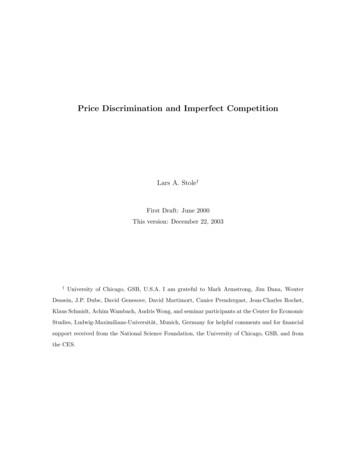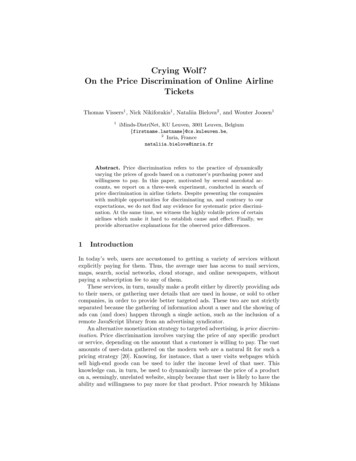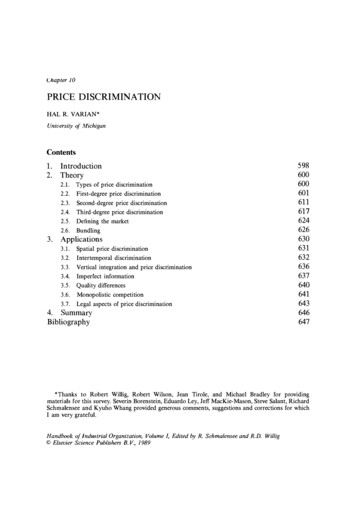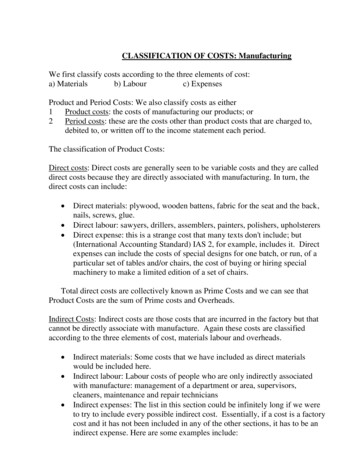
Transcription
Price Discrimination and Imperfect CompetitionLars A. Stole†First Draft: June 2000This version: December 22, 2003†University of Chicago, GSB, U.S.A. I am grateful to Mark Armstrong, Jim Dana, WouterDessein, J.P. Dube, David Genesove, David Martimort, Canice Prendergast, Jean-Charles Rochet,Klaus Schmidt, Achim Wambach, Audris Wong, and seminar participants at the Center for EconomicStudies, Ludwig-Maximilians-Universität, Munich, Germany for helpful comments and for financialsupport received from the National Science Foundation, the University of Chicago, GSB, and fromthe CES.
Contents1 Introduction12 First-degree price discrimination63 Third-degree price discrimination83.1Welfare analysis . . . . . . . . . . . . . . . . . . . . . . . . . . . . . . . . . .83.2Cournot models of third-degree price discrimination . . . . . . . . . . . . .93.3A tale of two elasticities: best-response symmetry in price games . . . . . .113.4When one firm’s strength is a rival’s weakness: best-response asymmetry inprice games . . . . . . . . . . . . . . . . . . . . . . . . . . . . . . . . . . . .173.5Price discrimination and entry . . . . . . . . . . . . . . . . . . . . . . . . .233.6Restrictions between firms to limit price discrimination . . . . . . . . . . . .264 Price Discrimination by Purchase History294.1Exogenous switching costs and homogeneous goods . . . . . . . . . . . . . .314.2Discrimination over revealed preferences from first-period choices . . . . . .354.3Purchase-history pricing with long-term commitment . . . . . . . . . . . . .385 Intrapersonal price discrimination416 Nonlinear pricing (second-degree price discrimination)446.1Monopoly second-degree price discrimination benchmark . . . . . . . . . . .466.2Nonlinear pricing with exclusive consumers and one-stop shopping . . . . .496.2.1One-dimensional models of heterogeneity . . . . . . . . . . . . . . .506.2.2Multi-dimensional models of heterogeneity . . . . . . . . . . . . . . .556.3Applications: Add-on pricing and the nature of price-cost margins . . . . .586.4Nonlinear pricing with consumers in common . . . . . . . . . . . . . . . . .616.4.1One-dimensional models . . . . . . . . . . . . . . . . . . . . . . . . .626.4.2Multi-dimensional models . . . . . . . . . . . . . . . . . . . . . . . .647 Bundling7.166Strategic commitments to bundle . . . . . . . . . . . . . . . . . . . . . . . .677.1.1Bundling for strategic foreclosure and entry deterrence . . . . . . . .677.1.2Committing to bundles for accommodation . . . . . . . . . . . . . .68
7.2Bundling without commitment . . . . . . . . . . . . . . . . . . . . . . . . .8 Demand uncertainty and price rigidities69718.1Monopoly pricing with demand uncertainty and price rigidities . . . . . . .748.2Perfect competition with demand uncertainty and price rigidities . . . . . .778.3Oligopoly with demand uncertainty and price rigidities . . . . . . . . . . . .798.4Sequential screening: advanced purchases and refunds . . . . . . . . . . . .799 Summary82
1IntroductionFirms frequently segment customers according to price sensitivity in order to price discriminate and increase profits. In some settings, consumer heterogeneity can be directly observedand a firm can base its pricing upon contractible consumer characteristics; in other settings,heterogeneity is not directly observable, but can be indirectly elicited by offering menus ofproducts and prices and allowing consumers to self-select. In both cases, the firm seeks toprice its wares as a function of each consumer’s underlying demand elasticity, extractingmore surplus and increasing sales to elastic customers in the process.When the firm is a monopolist with market power, the underlying theory of price discrimination is now well understood, as explained, for example, by Varian (1989) in an earliervolume in this series.1 On the other extreme, when markets are perfectly competitive andfirms have neither short-run nor long-run market power, the law of one price applies andprice discrimination cannot exist.2 Economic reality, of course, largely lies somewhere inbetween the textbook extremes, and most economists agree that price discrimination arisesin oligopoly settings.3 This chapter explores price discrimination in these imperfectly competitive markets, surveying the theoretical literature.Price discrimination exists when prices vary across customer segments that cannot beentirely explained by variations in marginal cost. Stigler’s (1987) definition makes thisprecise: a firm price discriminates when the ratio of prices is different from the ratio of1Besides Varian (1989), this survey benefited greatly from several other excellent surveys of price discrimination, including Phlips (1983), Tirole (1988, ch. 3) and Wilson (1993).2It is straightforward to construct models of price discrimination in competitive markets without entrybarriers in which firms lack long-run market power (and earn zero long-run economic profits), providing thatthere is some source of short-run market power that allows prices to remain above marginal cost, such as afixed cost of production. For example, a simple free-entry Cournot model as discussed in section 3.2 withfixed costs of production will exhibit zero long-run profits, prices above marginal cost, and equilibrium pricediscrimination. The fact that price discrimination can arise in markets with zero long-run economic profitssuggests that the presence of price discrimination is a misleading proxy for long-run market power. Thispossibility is the subject of a recent symposium published in the Antitrust Law Journal (2003, Vol. 70, No.3); see the papers by Baker (2003), Baumol and Swanson (2003), Hurdle and McFarland (2003), Klein andWiley (2003a, 2003b), and Ward (2003) for the full debate.3Much empirical work tests for the presence of price discrimination in imperfectly competitive environments. An incomplete sample of papers and markets includes: Shepard (1991)–gasoline service stations,Graddy (1995)–fish market, Goldberg (1995) and Verboven (1996)–European automobiles, Leslie (1999)–Broadway theater, Busse and Rysman (2001)–yellow pages advertising, Clerides (2001b)–books, Cohen(2001)–paper towels, Crawford and Shum (2001)–cable television, McManus (2001)–specialty coffee, Nevoand Wolfram (2002)–breakfast cereal, Besanko, Dube and Gupta (2001)–ketchup. For the minority viewpoint that price discrimination is less common in markets than typically thought, see Lott and Roberts(1991).1
marginal costs for two goods offered by a firm.4 Such a definition, of course, requiresthat one is careful in calculating marginal costs to include all relevant shadow costs. Thisis particularly true where costly capacity and aggregate demand uncertainty play criticalroles, as discussed in section 8. Similarly, where discrimination occurs over the provision ofquality, as reviewed in section 6, operationalizing this definition requires using the marginalprices of qualities and the associated marginal costs.Even with this moderately narrow definition of price discrimination, there remains aconsiderable variety of theoretical models that address issues of price discrimination and imperfect competition. We further limit attention in this survey to the straightforward settingof symmetric firms competing in a retail market; even here, there are numerous theories toexplore. These include third-degree price discrimination (section 3), purchase-history pricediscrimination (section 4), intrapersonal price discrimination (section 5), second-degree pricediscrimination and nonlinear pricing (section 6), product bundling (section 7), and demanduncertainty and price rigidities (section 8). Unfortunately, we must prune a few additionalareas of inquiry, leaving some models of imperfect competition and price discriminationunexamined. Among the more notable omissions in this chapter are price discriminationin vertical structures,5 imperfect information and costly search,6 the commitment effect of4Clerides (2001a) contrasts Stigler’s ratio definition with a price-levels definition (which focuses on thedifference between price and marginal cost), and discusses the relevance of this distinction to a host ofempirical studies.5For example, in a vertical market where a single manufacturer can price discriminate across downstreamretailers, there are a host of issues regarding resale-price maintenance, vertical foreclosure, etc. As a simpleexample, a rule requiring that the wholesaler offer a single price to all retailers may help the upstream firmto commit to not flood the retail market, thereby raising profits and retail prices. While these issues ofvertical markets are significant, we leave them largely unexplored in the present paper. Some of these issuesare considered elsewhere in this volume; see, for example, Rey and Tirole (2003).6The role of imperfect information and costly search in imperfectly competitive environments has previously received attention in the first volume of this series (Varian (1989, ch. 10, section 3.4) and Stiglitz(1989, ch. 13)). To summarize, when customers differ according to their information about market prices(or their costs of acquiring information), a monopolist may be able to segment the market by offering adistribution of prices, as in the model by Salop (1977), where each price observation requires a costly searchby the consumer. A related set of competitive models has been explored by numerous authors includingVarian (1980, 1981), Salop and Stiglitz (1977, 1982), Rosenthal (1980) and Stahl (1989). Unlike Salop(1977), in these papers each firm offers a single price in equilibrium. In some variations, firms choose from acontinuous equilibrium distribution of prices; in others, there are only two prices in equilibrium, one for theinformed and one for the uninformed. In most of these papers, average prices increase with the proportionof uninformed consumers and, more subtly, as the number of firms increases, the average price level canincrease toward the monopoly level. These points are made in Stahl (1989). Nonetheless, in these papersprice discrimination does not occur at the firm level, but across firms. That is, each firm offers a single pricein equilibrium, while the market distribution of prices effectively segments the consumer population intoinformed and uninformed buyers. Katz’s (1984) model is an exception to these papers by introducing theability of firms to set multiple prices to sort between informed and uninformed consumers; this contributionis reviewed in section 3.5. At present, competitive analogs of Salop’s (1977) monopoly price discrimination2
price discrimination policies,7 collusion and intertemporal price discrimination8 , and thestrategic effect of product lines in imperfectly competitive settings.9It is well known that price discrimination is only feasible under certain conditions:(i) firm(s) have short-run market power, (ii) consumers can be segmented either directlyor indirectly, and (iii) arbitrage across differently priced goods is infeasible. Given thatthese conditions are satisfied, an individual firm will typically have an incentive to pricediscriminate. The form of price discrimination will depend importantly on the nature ofmarket power, the form of consumer heterogeneity, and the availability of various segmentingmechanisms.When a firm is a monopolist, it is simple to catalog the various forms of price discrimination according to the form of consumer segmentation. To this end, suppose that aconsumer’s preferences for a monopolist’s product are given byU v(q, θ) y,where q is the amount (quantity or quality) consumed of the monopolist’s product, y isnumeraire, and consumer heterogeneity is captured in θ (θo , θu ). The vector θ has twocomponents. The first component, θo , is observable and prices may be conditioned upon itsvalue; the second component, θu , is unobservable and is known only to the consumer. Wesay that the monopolist is practicing direct price discrimination to the extent that its pricesdepend upon observable heterogeneity. Generally, this implies that the price of purchasingq units of output will be a function that depends upon θo : P (q, θo ). When the firm furtherchooses to offer linear price schedules, P (q, θo ) p(θo )q, we say the firm is practicingthird-degree price discrimination over the characteristic θo . If there is no unobservableheterogeneity and consumers have rectangular demand curves, then all consumer surplusmodel, in which each firm offers multiple prices in equilibrium, have not been well explored.7While the chapter gives a flavor of a few of the influential papers on this topic, the treatment is leftlargely incomplete.8For instance, Gul (1987) shows that when durable-goods oligopolists can make frequent offers, unlikethe monopolist, they can improve their ability to commit to high prices and obtain close to full-commitmentmonopoly profits.9A considerable amount of study has also focused on how product lines should be chosen to soften secondstage price competition. While the present survey considers the effect of product line choice in segmentingthe marketplace (e.g. second-degree price discrimination), it is silent about the strategic effects of lockinginto a particular product line (i.e., a specific set of locations in a preference space). A now large set ofresearch has been devoted to this topic, including papers by Brander and Eaton (1984), Klemperer (1992)and Gilbert and Matutes (1993), to list a few.3
is extracted and third-degree price discrimination is perfect price discrimination. Moregenerally, if there is additional heterogeneity over θu or downward-sloping individual demandcurves, third-degree price discrimination will leave some consumer surplus.When the firm does not condition its price schedule on observable consumer characteristics, every consumer is offered the same price schedule, P (q). We say the firm indirectlyprice discriminates if the marginal price varies across consumer types at their chosen consumption levels; i.e., P 0 (q(θ)) is not constant in θ, where q(θ) arg maxq v(q, θ) P (q).A firm can typically extract greater consumer surplus by varying the marginal price andscreening consumers according to their revealed consumptions. This use of nonlinear pricing as a sorting mechanism is typically referred to as second-degree price discrimination.10More generally, in a richer setting with heterogeneity over observable and unobservablecharacteristics, we expect that the monopolist will practice some combination of direct andindirect price discrimination—offering P (q, θo ), but using the price schedule to sort overunobservable characteristics.While one can categorize price discrimination strategies as either direct or indirect, itis also useful to catalog strategies according to whether they discriminate across consumers(interpersonal price discrimination) or across units for the same consumer (intrapersonalprice discrimination). Intrapersonal price discrimination is a variation of price/marginalcost ratios across the portfolio of goods purchased by a given consumer (i.e., cross-consumerheterogeneity is held constant). For example, suppose that there is no interconsumer heterogeneity so that θ is fixed. There will generally remain some intraconsumer heterogeneityover the marginal value of each unit of consumption so that a firm cannot extract all consumer surplus using a linear price. Here, a firm can capture the consumer surplus associatedwith intraconsumer heterogeneity, either by offering a nonlinear price schedule equal to theindividual consumer’s compensated demand curve or by offering a simpler two-part tariff.10Pigou (1920) introduced the terminology of first-, second- and third-degree price discrimination. Thereis some confusion, however, regarding Pigou’s original definition of second-degree price discrimination andthat of many recent writers (e.g., see Tirole (1988)) who include self-selection via nonlinear pricing as aform of second-degree discrimination. Pigou (1920) did not consider second-degree price discrimination asa selection mechanism, but rather thought of it as an approximation of first-degree using a step functionbelow the consumer’s demand curve and, as such, regarded both first and second-degrees of price discrimination as “scarcely ever practicable” and “of academic interest only.” Dupuit (1847) gives a much cleareracknowledgment of the importance of self-selection constraints in segmenting markets, although without ataxonomy of price discrimination. We follow the modern use of second-degree price discrimination to includeindirect segmentation via nonlinear pricing.4
We will address these issues more in section 5.11 Elsewhere in this chapter, we will focus oninterpersonal price discrimination, with the implicit recognition that intra-personal pricediscrimination often occurs simultaneously.The methodology of monopoly price discrimination is both useful and misleading in illuminating the effects of discrimination by imperfectly competitive firms. It is useful becausethe monopoly methods can frequently be used to calculate each firm’s best response to itscompetitors’ policies. Just as one can solve for the best-response function in a Cournotquantity game by deriving a residual demand curve and proceeding as if the firm was a monopolist on this residual market, we can also solve for best responses in more complex pricediscrimination games by deriving residual market demand curves. Unfortunately, our intuitions from the monopoly models can be misleading, because we are ultimately interestedin the equilibrium of the firms’ best-response functions rather than a single optimal pricingstrategy. For example, while it is certainly the case that, ceteris paribus, a single uniformpricing firm will weakly benefit by introducing price discrimination, if every firm were toswitch from uniform pricing to price discrimination, profits may fall for the entire industry.Whether profits fall depends upon whether the additional surplus extraction allowed byprice discrimination (the standard effect in the monopoly setting) exceeds the additionalcompetitive externality if discrimination increases the intensity of price competition. Thiscomparison, in turn, depends upon the details of the markets, as will be explained. Thepages that follow consist largely of evaluations of these interactions between price discrimination and imperfect competition.When evaluating the impact of price discrimination in imperfectly competitive environments, two related comparisons are relevant. First, starting from a setting of imperfectcompetition and uniform pricing, what are the welfare changes from allowing firms to pricediscriminate? Second, starting from a setting of monopoly and price discrimination, whatare the welfare effects of increasing competition? Because the theoretical predictions of themodels often depend upon the nature of competition, consumer preferences and consumerheterogeneity, we shall pursue these questions by examining a collection of specialized models that illuminate the broad themes of this literature and illustrate how the implicationsof competitive price discrimination compare to uniform pricing and monopoly.In sections 2-7, we explore variations on these themes, by varying the forms of com11See Armstrong and Vickers (2001) for a more detailed discussion of intrapersonal price discriminationand its relevance.5
petition, preference heterogeneity, and segmenting devices. Initially in section 2, we beginwith the benchmark of first-degree, perfect price discrimination. In section 3, we turn tothe classic setting of third-degree price discrimination, applied to the case of imperfectlycompetitive firms. In section 4, we examine an important class of models that extends thirddegree price discrimination to dynamic settings, where price offers may be conditioned ona consumer’s purchase history from rivalsa form of price discrimination that can only existunder competition. In section 5, we study intrapersonal price discrimination. Section 6brings together several diverse theoretical approaches to modeling imperfectly competitivesecond-degree price discrimination, comparing and contrasting the results to those undermonopoly. Product bundling (as a form of price discrimination) in imperfectly competitivemarkets is reviewed in section 7. Models of demand uncertainty and price rigidities areintroduced in section 8.2First-degree price discriminationFirst-degree (or perfect) price discrimination—which arises when the seller can capture allconsumer surplus by pricing each unit at precisely the consumer’s marginal willingness topay—serves as an important benchmark and starting point for exploring more subtle formsof pricing. When the seller controls a monopoly, the monopolist obtains the entire socialsurplus, and so profit maximization is synonymous with maximizing social welfare. Howdoes the economic intuition of this simple model translate to oligopoly?The oligopoly game of perfect price discrimination is quite simple to analyze, even in itsmost general form. Following Spulber (1979), suppose that there are n firms, each sellinga (possibly differentiated) product, but that each firm has the ability to price discriminatein the first degree and extract all of the consumer surplus under its residual demand curve.Specifically, suppose the residual demand curve for firm i is given by pi Di (qi , q i ), whenits rivals perfectly price discriminate and choose the vector q i (q1 , . . . , qi 1 , qi 1 , . . . , qn ).In addition, let Ci (qi ) be firm i’s cost of producing qi units of output; the cost function isincreasing and convex. The ability to then perfectly price discriminate when selling qi unitsof output implies that firm i’s profit function isZqiDi (y, q i )dy Ci (qi ).πi (qi , q i ) 06
A Nash equilibrium is a vector of outputs, (q1 , . . . , qn ), such that each firm’s output, qi , is : formally, for all i and q , π (q , q ) a best-response to the output vector of its rivals, q iii i i ). As Spulber (1979) noted, the assumption of perfect price discrimination—inπi (qi , q itandem with the assumption that residual demand curves are downward sloping—impliesthat each firm i’s profit function is strictly concave in its own output for any output vectorof its rivals. Hence, the existence of a pure-strategy Nash equilibrium in quantities followsimmediately. The equilibrium allocations are entirely determined by marginal-cost pricing ) C 0 (q ).12based on each firm’s residual demand curve: Di (qi , q ii iIn this oligopoly game of perfect price discrimination, the marginal consumer purchasesat marginal cost, so, under mild technical assumptions, social surplus is maximized. In thissetting, unlike the imperfect price discrimination settings which follow, the welfare effectof price discrimination is immediate, just as in monopoly perfect price discrimination. Afew differences exist, however. First, while consumers obtain none of the surplus under theresidual demand curves, it does not follow that consumers obtain no surplus at all; rather,for each firm i, they obtain no surplus from the addition of the ith firm’s product to thecurrent availability of n 1 other goods. If the goods are close substitutes and marginal costsare constant, the residual demand curves are highly elastic and consumers may nonethelessobtain considerable non-residual surplus from the presence of competition. The net effect ofprice discrimination on total consumer surplus requires an explicit treatment of consumerdemand.Second, it may be the case that each firm’s residual demand curve is more elastic whenits rivals can perfectly price discriminate than when they are forced to price uniformly.Thus, while each firm prefers the ability to perfectly price discriminate itself, the totalindustry profit may fall when price discrimination is allowed, depending on the form ofcompetition and consumer preferences. We will see a clear example of this in the Hotellingdemand model of Thisse and Vives (1988) which examines discriminatory pricing based onobservable location. In this simple setting, third-degree price discrimination is perfect, butfirms are worse off and would prefer to commit collectively to uniform-pricing strategies.Third, if n is endogenous, if entry with fixed costs occurs until long-run profits are driven12This general existence result contrasts with the more restrictive assumptions required for pure-strategyNash equilibria in when firms’ strategies are limited to choosing a fixed unit price for each good. Spulber(1979) also demonstrates that if an additional stability restriction on the derivatives of the residual demandcurves is satisfied, this equilibrium is unique.7
to zero, and if consumer surplus is entirely captured by price discrimination, then pricediscrimination lowers social welfare compared to uniform pricing. This conclusion followsimmediately from the fact that consumer surplus is zero and entry dissipates profits, leadingto zero social surplus from the presence of the market. Uniform pricing typically leaves someconsumer surplus (and hence positive social welfare). Again, whether consumer surplus isentirely captured by price discrimination requires a more explicit analysis of demand.Rather than further explore the stylized setting of first-degree price discrimination, weinstead turn to explicit analyses undertaken for each of the imperfect price discriminationstrategies studied in the ensuing sections.3Third-degree price discriminationThe classic theory of third-degree price discrimination by a monopolist selling to severaldistinct markets is straightforward: the optimal price-discriminating prices are found by applying the familiar inverse-elasticity rule to each market separately. If instead of monopoly,however, oligopolists compete in each market, then each firm applies the inverse-elasticityrule using its own residual demand curve—an equilibrium construction. Here, the crossprice elasticities of demand play a central role in determining equilibrium prices and outputs.These cross-price elasticities, in turn, depend critically upon consumer preferences and theform of consumer heterogeneity.3.1Welfare analysisWith third-degree price discrimination, there are three potential sources of social inefficiency. First, aggregate output over all market segments may be too low if prices exceedmarginal cost. To this end, we seek to understand the conditions for which price discrimination leads to an increase or decrease in aggregate output relative to uniform pricing.Second, for a given level of aggregate consumption, price discrimination will typically generate interconsumer misallocations relative to uniform pricing; hence, aggregate output willnot be efficiently distributed to the highest-value ends. And third, there may be inter-firminefficiencies as a given consumer may be served by an inefficient firm, perhaps purchasingfrom a more distant or higher-cost firm to obtain a price discount.In the following, much is made of the relationship between aggregate output and welfare.If the same aggregate output is generated under uniform pricing as under price discrim8
ination, then price discrimination must necessarily lower social welfare because output isallocated with multiple prices; with a uniform price, interconsumer misallocations are notpossible. Therefore, holding production inefficiencies fixed, an increase in aggregate output is a necessary condition for price discrimination to increase welfare under monopoly.Varian (1985) made this point in the context of monopoly, but the economic logic appliesmore generally to imperfect competition, providing that the firms are equally efficient atproduction and the number of firms is fixed.13 Because we can easily make statements onlyabout aggregate output for many models of third-degree price discrimination, this resultwill prove useful, giving us some limited power to draw welfare conclusions.There are two common approaches to modeling imperfect competition: quantity competition with homogeneous goods and price competition with product differentiation. Thesimple quantity-competition model of oligopoly price discrimination is presented in section3.2. We then turn to price-setting models of competition. Within price-setting games, wefurther distinguish two sets of models based upon consumer demands. In the first setting(section 3.3), all firms agree in their ranking of high-demand (or “strong”) markets andlow-demand (or “weak”) markets. Here, whether the strong markets are more competitivethan the weak markets is critical for many economic conclusions. In the second setting(section 3.4), firms are asymmetric in their ranking of strong and weak markets; e.g., firma’s strong market is firm b’s weak market and conversely. With asymmetry, equilibriumprices can move in patterns that are not possible under symmetric rankings and differenteconomic insights present themselves. Following the treatment of price-setting games, wetake up the topics of third-degree price discrimination with endogenous entry (section 3.5)and private restrictions on price discrimination (section 3.6).3.2Cournot models of third-degree price discriminationPerhaps the simplest model of imperfect competition and price discrimination is the immediate extension of Cournot’s quantity-setting, homogeneous-good game to firms competing13Varian (1985) generalizes Schmalensee’s (1981) necessary condition for welfare improvements by considering more general demand and cost settings, and also by establishing a lower (sufficient condition) boundon welfare changes. Schwartz (1990) extends Varian’s boundary results to cases in which marginal costsare decreasing. Additional effects arising from heterogeneous firms alter the application of these welfareresults to oligopoly, as noted by Galera (2003). It is possible, for example, that price
third-degree price discrimination over the characteristic θ o. If there is no unobservable heterogeneity and consumers have rectangular demand curves, then all consumer surplus model, in which each firm offers mul










